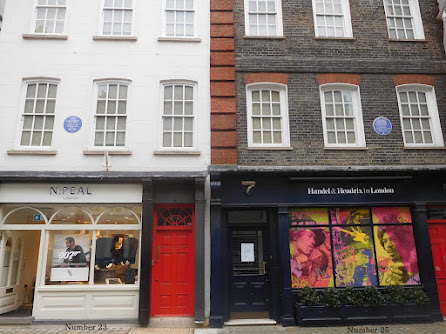Coffee, the blues, and baroque in London's Mayfair
THERE ARE TWO entrances to
Lancashire Court from Mayfair’s Brook Street. One of them, the closest to New
Bond Street, is a cobbled lane leading down to a courtyard occupied by the back
entrance of the Victoria’s Secret store and the outdoor tables of a restaurant
called Hush Mayfair. The tables under delightfully decorated canopies looked
enticing, and as we felt the need for some coffee, we sat down to enjoy small
macchiatos (maybe more correctly, ‘macchiati’). The coffees were enjoyable but
not exceptional. However, the bill that arrived after we had drunk our tiny
coffees was far from unexceptional. We were charged just under £13 (US $17.46,
INR 1300, or EUROS 15.25) for our two hot drinks. Just in case you are not
familiar with the London café scene, today, November 2021, two macchiatos usually
cost between £4 and £6.
Lancashire Court is a network of lanes
and courtyards located behind the buildings on the southwest corner of the
intersection of New Bond Street and Brook Street. It was once a part of London,
the Conduit Mead Estate (www.ianvisits.co.uk/blog/2021/07/05/londons-alleys-lancashire-court-w1/,
an informative web page), that followed the course of an old water conduit that
ran through the area in a north/south direction (for a map of the district, see:
www.bl.uk/onlinegallery/onlineex/crace/t/largeimage88092.html).
From the 1730s until the 1970s, the buildings in Lancashire Court included many
workshops, warehouses, and builder’s yards. In 1987, there was a plan to
demolish the network of alleys and replace it with a new shopping complex, but
this never materialised. Now, the old businesses have been replaced by ‘chic’
establishments including the place where we enjoyed our exorbitantly priced
coffees.
Returning to Brook Street, the short
section lying between the two entrances to Lancashire Court has two
neighbouring houses, numbers 23 and 25, which have importance in the history of
music in London. The composer of well-known works such as “The Messiah” and “The
Water Music”, George Frideric Handel (1685-1759), moved into what is now number
23 in the summer of 1723, and lived there until his death (https://handelhendrix.org/plan-your-visit/whats-here/handel-house/).
In Handel’s time, Brook Street was known as ‘Lower Brook Street’. Handel’s home
included a Music Room in which as many as 40 people would be accommodated to
perform and listen to Handel’s latest creations.
In 1968, 209 years after Handel
died, another musician moved into number 25, the house next door to number 23
Brook Street. Like Handel, the occupant of number 25 was a musical innovator.
His name was Jimi Hendrix (1942-1970). According to a useful website (https://handelhendrix.org/plan-your-visit/whats-here/hendrix-flat/):
“The flat on the upper floors of 23
Brook Street was found by Jimi’s girlfriend Kathy Etchingham from an advert in
one of the London evening newspapers in June 1968 while he was in New York. He
moved in briefly in July before returning to the United States for an extensive
tour. He spent some time decorating the flat to his own taste, including
purchasing curtains and cushions from the nearby John Lewis department store,
as well as ornaments and knickknacks from Portobello Road market and elsewhere.
He told Kathy that this was ‘my first real home of my own’.
He returned to Brook Street in
January 1969 and almost immediately launched into an exhaustive series of press
and media interviews and photo shoots in the flat. On 4 January he made his
infamous appearance on the BBC Happening for Lulu TV show, and gave his two
Royal Albert Hall concerts in February. In March he was back in New York again
and although Kathy remained at Brook Street for a while longer Jimi did not
live there again.”
After Hendrix’s girlfriend left the
flat, it was used as office space. In 2000, it was taken over by the Handel
House Trust. By 2016, both Handel’s House and Hendrix’s flat became open to the
public as a museum, which I have yet to visit. Sadly, since the onset of the
covid19, the museum, now known as ‘Handel and Hendrix in London’ is only open
occasionally and will open fully in March 2023.

The westernmost of the two Brook
Street entrances to Lancashire Court is lined with an attractive mural made
from ceramic tiles. Created in 2001 by Michael Czerwiǹski (with Ray Howell), it
celebrates Handel’s residence in Brook Street. Amongst the many works he
composed whilst living there, here is a very small selection of them: the opera
“Rodelinda”; “The Messiah” and “Semele”; and “Music for the Royal Fireworks”.
Each of the two musicians of Brook
Street did much to change the course of musical history. I wonder what each
would have thought of the other, and which of them has the most listeners
today. Whatever the answers, their names will live on in people’s minds far
longer than that of both the place where we had costly coffee and the currently
trendy Victoria Secret high-end but low-cut lingerie store.













No comments:
Post a Comment
Useful comments and suggestions are welcome!